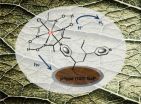(Press-News.org) We often think of playing fair as an altruistic behavior. We're sacrificing our own potential gain to give others what they deserve. What could be more selfless than that? But new research from Northeastern University assistant professor of philosophy Rory Smead suggests another, darker origin behind the kindly act of fairness.
Smead studies spite. It's a conundrum that evolutionary biologists and behavioral philosophers have been mulling over for decades, and it's still relatively unclear why the seemingly pointless behavior sticks around. Technically speaking, spite is characterized as paying a cost to harm another. It yields virtually no positive outcome for the perpetrator. So why would evolution—which is supposed to weed out such behaviors—let spite stick around?
Smead's research, conducted in collaboration with Patrick Forber of Tufts University and recently published in the journal Proceedings of the Royal Society B, sheds new light on this nefarious phenomenon.
A common means of studying social behaviors is through simplified models and games. One of these is called the ultimatum game, in which a one player proposes a division of resources the other player can either accept or reject. Suppose each interaction concerns the distribution of 10 one-dollar bills. The first player could suggest that he take $5 for himself and give the remaining $5 to the second player. That would be a fair play.
However, that first player could also go for an unfair option in which he keeps $9 for himself and gives just $1 to the second player. While the second player is worse off if he rejects the proposal (he's got ziltch in his pocket instead of $1), he almost always does so in real-world versions of the game: It's just not fair.
But when Smead and his colleagues decided to simulate this game mathematically to see how it would play out, they found that in fact the exact opposite happens. Fairness usually gets flushed out of the system since it's more beneficial for both the first player (the proposer) to suggest unfair offers and for the second player (the responder) to accept them.
"Evolutionary models don't match what we're observing in real life," Smead said. Clearly, he thought, there must be something else going on.
In the new study, Smead and Forber considered that the ultimatum game is actually quite unlike the real world. It's an extremely simplified simulation of one of infinite ways that two individuals could act. The researchers couldn't, for obvious reasons, make the game as complex and nuanced as real world social interactions, but they could instead just add a little more nuance to it and see what happened.
So that's what they did. In their new version of the game, the researchers introduced something called "negative assortment." Think of assortment as the likelihood that a person you're interacting with is similar to you. In negative assortment, that likelihood is low, so in the ultimatum game the players would likely use different strategies.
Here's where spite comes back into play. If you and I both commit to just making fair offers, but my strategy is to accept all offers—be they fair or unfair—and yours is to accept only fair ones, we are different. A spiteful strategy would be to both make only unfair offers, but reject such offers when they come from the other person.
In the original version of the ultimatum game, a spiteful player will usually walk away with nothing and forfeit the game. But with negative assortment, spite becomes common and actually ends up promoting fairness. "Acting fairly protects you from spite," Smead explained.
Think of it this way. A "gamesman" is someone who only makes unfair offers to benefit himself but accepts whatever comes his way because he believes it'll all wash out in the end. "Gamesmen become a target for spite because they're making unfair offers," Smead said. The "spiters" will reject those offers, eventually killing off the gamesmen.
But fair players will now do quite well in the presence of spite. Since they don't make unfair offers, they don't risk being rejected by the spiteful players. Fairness actually becomes a strategy for survival in this land of spite.
"Real social life is complicated," Smead said. While his new version of the ultimatum game is still a simplification, it illuminates another possible explanation for fair behavior that hadn't been considered before.
INFORMATION: END
The dark side of fair play
2014-03-07
ELSE PRESS RELEASES FROM THIS DATE:
Service is key to winery sales
2014-03-07
ITHACA, N.Y. – To buy, or not to buy? That is the question for the more than 5 million annual visitors to New York's wineries. Cornell University researchers found that customer service is the most important factor in boosting tasting room sales, but sensory descriptions of what flavors consumers might detect were a turn-off.
The findings stem from two studies on how the tasting room experience affects customer purchases and what wineries can do to create satisfied sippers, published in the current issue of the International Journal of Wine Business Research.
"On average, ...
Ever-so-slight delay improves decision-making accuracy
2014-03-07
NEW YORK, NY (March 7, 2014) — Columbia University Medical Center (CUMC) researchers have found that decision-making accuracy can be improved by postponing the onset of a decision by a mere fraction of a second. The results could further our understanding of neuropsychiatric conditions characterized by abnormalities in cognitive function and lead to new training strategies to improve decision-making in high-stake environments. The study was published in the March 5 online issue of the journal PLoS One.
"Decision making isn't always easy, and sometimes we make errors ...
Notre Dame chemists discover new class of antibiotics
2014-03-07
A team of University of Notre Dame researchers led by Mayland Chang and Shahriar Mobashery have discovered a new class of antibiotics to fight bacteria such as methicillin-resistant Staphylococcus aureus (MRSA) and other drug-resistant bacteria that threaten public health. Their research is published in the Journal of the American Chemical Society in an article titled "Discovery of a New Class of Non-beta-lactam Inhibitors of Penicillin-Binding Proteins with Gram-Positive Antibacterial Activity."
The new class, called oxadiazoles, was discovered in silico (by computer) ...
New theory on cause of endometriosis
2014-03-07
Changes to two previously unstudied genes are the centerpiece of a new theory regarding the cause and development of endometriosis, a chronic and painful disease affecting 1 in 10 women.
The discovery by Northwestern Medicine scientists suggests epigenetic modification, a process that enhances or disrupts how DNA is read, is an integral component of the disease and its progression. Matthew Dyson, research assistant professor of obstetrics and gynecology at Northwestern University Feinberg School of Medicine and and Serdar Bulun, MD, chair of obstetrics and gynecology ...
Bone turnover markers predict prostate cancer outcomes
2014-03-07
(SACRAMENTO, Calif.) —Biomarkers for bone formation and resorption predict outcomes for men with castration-resistant prostate cancer, a team of researchers from UC Davis and their collaborators have found. Their study, published online in the Journal of the National Cancer Institute, also found that the markers identified a small group of patients who responded to the investigational drug atrasentan. The markers' predictive ability could help clinicians match treatments with individual patients, track their effectiveness and affect clinical trial design.
Castration-resistant ...
Promising news for solar fuels from Berkeley Lab researchers at JCAP
2014-03-07
There's promising news from the front on efforts to produce fuels through artificial photosynthesis. A new study by Berkeley Lab researchers at the Joint Center for Artificial Photosynthesis (JCAP) shows that nearly 90-percent of the electrons generated by a hybrid material designed to store solar energy in hydrogen are being stored in the target hydrogen molecules.
Gary Moore, a chemist and principal investigator with Berkeley Lab's Physical Biosciences Division, led an efficiency analysis study of a unique photocathode material he and his research group have developed ...
Anti-psychotic medications offer new hope in the battle against glioblastoma
2014-03-07
Researchers at the University of California, San Diego School of Medicine have discovered that FDA-approved anti-psychotic drugs possess tumor-killing activity against the most aggressive form of primary brain cancer, glioblastoma. The finding was published in this week's online edition of Oncotarget.
The team of scientists, led by principal investigator, Clark C. Chen, MD, PhD, vice-chairman, UC San Diego, School of Medicine, division of neurosurgery, used a technology platform called shRNA to test how each gene in the human genome contributed to glioblastoma growth. ...
Agricultural fires across the Indochina landscape
2014-03-07
Agricultural fires are still burning in Indochina ten days after the last NASA web posting about the fires. This natural-color image, taken on March 07, 2014, by the Moderate Resolution Imaging Spectroradiometer, MODIS, aboard the Aqua satellite, shows a more comprehensive area of burning agricultural fires that stretch from Burma through to Laos and south throughout Thailand. Actively burning areas, detected by MODIS's thermal bands, are outlined in red.Fire is used in cropland areas for pest and weed control and to prepare fields for planting. Crop residue burning helps ...
NYU researchers find majority of Latinas are unaware of their risk of diabetes
2014-03-07
Approximately 5.5 million Latinas suffer from elevated fasting plasma glucose (FPG) and nearly 4 million of those women were never told by a healthcare provider they were at risk for diabetes, pre-diabetes, or were borderline for diabetes.
The study, "Latinas with Elevated Fasting Plasma Glucose: An Analysis Using NHANES 2009-2010 Data," led by Dr. Shiela M. Strauss, Associate Professor, New York University College of Nursing (NYUCN), points to the urgent need for alternate sites of opportunity for diabetes screenings. There is also a need for effective and culturally ...
Smartphones become 'eye-phones' with low-cost devices developed by Stanford
2014-03-07
STANFORD, Calif. — Researchers at the Stanford University School of Medicine have developed two inexpensive adapters that enable a smartphone to capture high-quality images of the front and back of the eye. The adapters make it easy for anyone with minimal training to take a picture of the eye and share it securely with other health practitioners or store it in the patient's electronic record.
"Think Instagram for the eye," said one of the developers, assistant professor of ophthalmology Robert Chang, MD.
The researchers see this technology as an opportunity to increase ...


